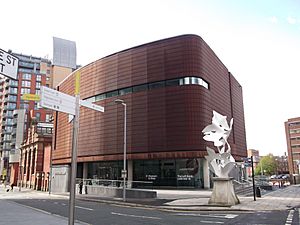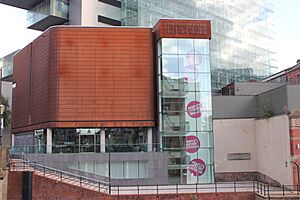People's History Museum facts for kids

The People's History Museum
|
|
| Lua error in Module:Location_map at line 420: attempt to index field 'wikibase' (a nil value). | |
| Former name | National Museum of Labour History |
|---|---|
| Location | Left Bank, Manchester, M3 3ER, United Kingdom |
| Type | History museum |
| Architect | Henry Price |
|
Listed Building – Grade II
|
|
| Official name: Former Hydraulic Power Station in grounds of City College | |
| Designated: | 22 July 1992 |
| Reference #: | 1254724 |
The People's History Museum in Manchester, England, is a special place. It's the UK's national museum dedicated to the history of working people. This means it collects, keeps, and shares stories about how everyday people in the UK lived and worked.
The museum shows how people's lives have changed over the last 200 years. It also tells the story of how people fought for their rights and for a fairer society. You can see old posters, objects, and photos. These show how people worked, rested, and played. Topics include how people gained the right to vote, the Peterloo Massacre, and the fight for women's rights. You can also learn about groups like trade unions and the cooperative movement.
Contents
A Look at the Museum's Past
The museum started its journey in London in 1975. It was run by a group called the Trade Union, Labour and Co-operative History Society. They kept their collection at a place called Limehouse Town Hall.
In 1986, the museum decided to move to Manchester. It reopened in 1990 at a historic building called the Mechanics' Institute. This building is also very old and important.
The Museum's New Home
In 1994, the museum opened another part at its current location on Bridge Street. This new part was inside an old hydraulic pumping station. Both museum sites were then renamed the People's History Museum in 2001.
The Bridge Street site closed for a big update in October 2007. It cost a lot of money to make it even better! The old pumping station was fixed up, and a new four-storey building was added next to it. A cool glass walkway now connects the two buildings. The museum officially reopened its doors on 13 February 2010.
What You Can See: The Collections
The People's History Museum has one of the biggest collections of political items in Britain. It shows how people fought for their right to vote and for a say in how the country is run.
Amazing Objects on Display
The museum has about 2,000 posters from elections and political campaigns. There are also 300 political cartoons, which are funny drawings with a message. You can see 7,000 trade union badges and tokens. Plus, there are 95,000 photographs showing people's lives.
The museum is also home to the world's largest collection of political and trade union banners. There are over 400 of them! These banners were carried in marches and protests. Visitors can even watch experts carefully fixing and preserving these old banners in the Textile Conservation studio.
Collecting Modern History
The museum doesn't just collect old things. It also tries to get items from recent history. For example, they tried to get a special stone from the 2015 general election. They also have documents related to important events like the 1984–1985 miners' strike. This helps them connect history to today's world.
The Labour History Archive
The museum also has a huge library of documents called the Labour History Archive and Study Centre. This archive holds important papers about the history of working people in Britain. It includes records from major political parties and groups. It also has documents about movements like Chartism, which was a big push for workers' rights in the 1800s.


